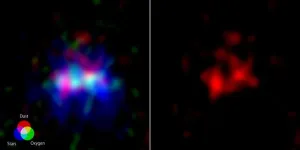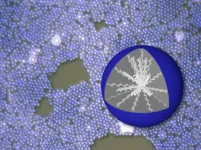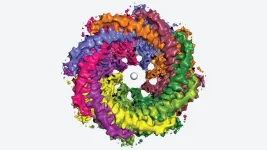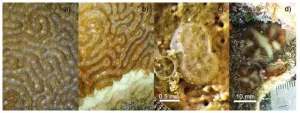(Press-News.org) New observations using the Atacama Large Millimeter/submillimeter Array (ALMA) have distinguished the sites of star formation and a possible site of star death from the surrounding nebula in a galaxy 13.2 billion light-years away. This is the farthest that such structures have been observed.
A team led by Yoichi Tamura, an astronomer at Nagoya University, attempted high-resolution observations of MACS0416_Y1, located 13.2 billion light-years away in the constellation Eridanus. Previous observations of this galaxy by the same team had detected radio waves emitted by both oxygen and dust, two components of interstellar nebulae. Detailed observations of the distribution of dust and oxygen can provide clues about how stars are born and die within nebulae, but the observations had lacked the resolution needed to see the structure of the nebulae.
This time the team observed with ALMA for 28 hours, zooming in on MACS0416_Y1. The results showed that the dust signal regions and oxygen emission regions are intricately intertwined, avoiding each other, suggesting the process where newly formed stars within the nebulae ionize the surrounding gas.
Furthermore, the team found a massive cavity spanning approximately 1,000 light-years in the dust dominated regions. When many new, massive and short-lived stars are born together, the resulting successive supernova explosions create enormous “superbubbles” in the nebulae. The discovered cavity may indeed be such a superbubble.
Takuya Hashimoto from the University of Tsukuba describes the observation performance as follows: “It corresponds to capturing the extremely weak light emitted by two fireflies located 3 centimeters apart on the summit of Mount Fuji as seen from Tokyo, and being able to distinguish between those two fireflies.”
Measurements of the motion of the gas in the nebulae indicate an environment where many stars may form together as massive clusters. Team leader Tamura explains the future prospects based on these results, “In the future, more detailed information can be obtained by conducting high-resolution observations of these star clusters themselves, using instruments such as the James Webb Space Telescope and the planned Extremely Large Telescopes.”
These observation results were published as Yoichi Tamura et al. “The 300 pc Resolution Imaging of a z = 8.31 Galaxy: Turbulent Ionized Gas and Potential Stellar Feedback 600 Million Years after the Big Bang” in the Astrophysical Journal.
END
Stellar cradles and graves seen in farthest galaxy ever
2023-07-14
ELSE PRESS RELEASES FROM THIS DATE:
Liquid crystals that mimic beetle shell coloration units used to create more secure type of QR code
2023-07-14
A research group led by Dr. Jialei He of Nagoya University's Graduate School of Engineering has developed a method for processing cholesteric liquid crystals (CLCs) into micrometer-sized spherical particles. CLCs are a type of liquid crystal that possess a helical structure, giving them unique optical properties and the ability to selectively reflect light. By combining spherical CLC particles with commercially available pigments, the researchers developed a unique anti-counterfeiting QR code that can only be displayed under a specific circular polarizer. The results were published in the journal Advanced Optical Materials.
CLCs are an example of how nature can be ...
ROSE: a revolutionary, nature-inspired soft embracing robotic gripper
2023-07-14
Ishikawa, Japan -- Although grasping objects is a relatively straightforward task for us humans, there is a lot of mechanics involved in this simple task. Picking up an object requires fine control of the fingers, of their positioning, and of the pressure each finger applies, which in turn necessitates intricate sensing capabilities. It’s no wonder that robotic grasping and manipulation is a very active research area within the field of robotics.
Today, industrial robotic hands have replaced humans in various complex and hazardous ...
Study shows surprisingly low use of COVID antiviral treatments in nursing homes
2023-07-14
Nursing homes were a key battleground during the COVID pandemic and prioritized for distribution of PPE, vaccines, and COVID testing kits. However, new research shows that monoclonal antibodies and oral antiviral drugs were not used in these facilities as much as would be expected given the high-risk of resident populations.
Brian McGarry, PhD, with the University of Rochester Medical Center, and collaborators at Harvard University, authored the new study, which appears today in JAMA. The authors examined data compiled ...
This eight-armed octopus-like pore detects taste
2023-07-14
The neurons in our bodies are dotted with tiny pores that let essential molecules pass in and out of our cells. Neurons need these channels to send the signals that allow us to move, think, and perceive the world around us. Now, structural biologists at Cold Spring Harbor Laboratory (CSHL) have captured never-before-seen images of one of the largest pores in human neurons. It’s called calcium homeostasis modulator protein 1, or CALHM1 for short.
Previous studies have shown that mutations in the Cahlm1 gene may be a risk factor for Alzheimer’s disease. CSHL’s new ...
New study demonstrates the potential of diseased coral parents in restoring stony coral tissue loss disease-affected species
2023-07-14
Stony Coral Tissue Loss Disease (SCTLD) has wreaked havoc on coral reefs across the Caribbean, resulting in significant mortality of various coral species, including Pseudodiploria strigosa, which has been particularly affected in the Mexican Caribbean. In response to the decreased abundance and colony density caused by SCTLD, scientists have explored larval-based restoration methods, despite concerns about disease transmission. A new PeerJ Life & Environment study reveals that even colonies affected by SCTLD can play a vital role in the assisted sexual reproduction for the restoration of SCTLD-susceptible species.
The ...
Owning a pet does not reduce symptoms of severe mental illness, study shows
2023-07-14
Living with and having a close bond with a companion animal does not necessarily lead to significant mental health improvements in people with a serious mental illness, say researchers.
A survey, conducted by the University of York, revealed that living with an animal - a dog, cat, fish or bird for example - did not improve wellbeing or reduce depression, anxiety or feelings of loneliness for owners with serious mental illness, such as bipolar disorder or schizophrenia, compared to those who live without an animal.
The researchers, who followed up on an earlier survey conducted in 2021 on investigating aspects of animal ownership and mental ...
AI brings hope for patients with lyosomal storage disease
2023-07-14
Artificial intelligence is becoming increasingly important in drug discovery. Advances in the use of Big Data, learning algorithms and powerful computers have now enabled researchers at the University of Zurich (UZH) to better understand a serious metabolic disease.
Cystinosis is a rare lyosomal storage disorder affecting around 1 in 100,000 to 200,000 newborns worldwide. Nephropathic (non-inflammatory) cystinosis, the most common and severe form of the disease, manifests with kidney disease symptoms ...
Pets do not significantly benefit the emotional health of owners with severe mental illness, study shows
2023-07-14
A new study published in the CABI journal Human-Animal Interactions suggests that companion animals – including dogs, cats, fish and birds – do not significantly benefit the emotional health of owners with severe mental illness.
Results showed that owning an animal was not significantly associated with the wellbeing, depression, anxiety or loneliness scores for owners with a range of severe mental illnesses such as bipolar disorder or psychosis.
The researchers, who followed up on an earlier survey conducted ...
Scientists knit futuristic eco-building designs using fungal networks
2023-07-14
Scientists hoping to reduce the environmental impact of the construction industry have developed a way to grow building materials using knitted molds and the root network of fungi. Although researchers have experimented with similar composites before, the shape and growth constraints of the organic material have made it hard to develop diverse applications that fulfil its potential. Using the knitted molds as a flexible framework or ‘formwork’, the scientists created a composite called ‘mycocrete’ which is ...
Ketamine effective for treatment-resistant depression: clinical trial
2023-07-14
A low-cost version of ketamine to treat severe depression has performed strongly in a double-blind trial that compared it with placebo.
In research published today in the British Journal of Psychiatry, researchers led by UNSW Sydney and the affiliated Black Dog Institute found that more than one in five participants achieved total remission from their symptoms after a month of bi-weekly injections, while a third had their symptoms improve by at least 50 per cent. The study was a collaboration between ...






